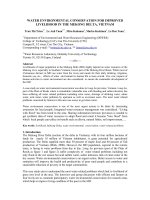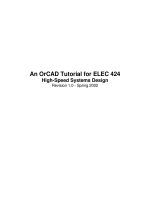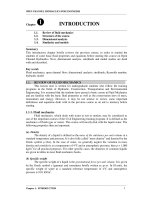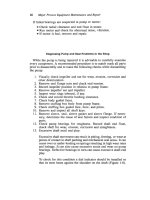Tài liệu INTERIOR LANDSCAPE PLANTS FOR INDOOR AIR POLLUTION ABATEMENT ppt
Bạn đang xem bản rút gọn của tài liệu. Xem và tải ngay bản đầy đủ của tài liệu tại đây (1.16 MB, 30 trang )
*,ed_
F
N/LRA
INTERIOR LANDSCAPE PLANTS FOR
INDOOR AIR POLLUTION ABATEMENT
FINAL REPORT SEPTEMBER 15, 1989
B.C. Wolverton, Ph.D.
Principal Investigator
Anne Johnson, M.S.
and
Keith Bounds, M.S.
Sverdrup Technology, Inc.
This work was jointly supported by the NASA Office of Commercial
Programs Technology Utilization Division, and the Associated Landscape
Contractors of America (ALCA).
National Aeronautics and Space Administration
John C. Stennis Space Center
Science and Technology Laboratory
Stennis Space Center, MS 39529-6000CONTENTS.
Abbreviations and Acronyms v
Introduction 1
A Promising, Economical Solution to Indoor Air Pollution 2
Chemicals Used In The Plant Screening Tests 3
Benzene 3
Trichloroethylene 5
Formaldehyde 5
Materials and Methods 6
Gas Chromatograph-Mass Selective Detector Analysis for Trace Metabolites 8
Microbiological Analysis 8
Activated Carbon-Houseplant Air Filter System 8
Results and Discussion 9
Summary 18
Acknowledgments 18
References 19
FIGURES
1. Indoor air purification system combining houseplants and activated carbon 3
2. Man's interaction with his environment plants, soil,
microorganisms, and water 4
3. Removal of low concentrations of benzene and trichloroethylene from the air
inside sealed experimental chambers using golden pothos in an 8-in. activated
carbon filter system 16
4. Removal of high concentrations of benzene and trichloroethylene from the air
inside sealed experimental chambers using golden pothos in an 8-in. activated
carbon filter system 17
.°°
III
PREC, EDING P:IGE E-,;'LA_',!K'_,"_':"
t., FILMED
TABLES
°
Trichloroethylene Removed from a Sealed Experimental Chamber by
Houseplants During a 24-h Exposure Period
.
Benzene Removed from a Sealed Experimental Chamber by
Houseplants During a 24-h Exposure Period
10
,
Formaldehyde Removed from a Sealed Experimental Chamber by
Houseplants and Soil During a 24-h Exposure Period
11
o
Chemicals Removed by Houseplants from a Sealed Experimental Chamber
During a 24-h Exposure Period
12
.
Benzene Removed from a Sealed Experimental Chamber by Houseplants
During a 24-h Exposure Period
12
.
Trichloroethylene Removal from a Sealed Experimental Chamber by
Houseplants During a 24-h Exposure Period
13
°
Benzene Removal from a Sealed Experimental Chamber by
Houseplants in Potting Soil and the Same Potting Soil after
Removing All Plant Foliage During 24-h Exposure Periods
14
.
Benzene Removal and Soil Bacterial Counts of a Chinese Evergreen Plant
after Being Exposed for Several 24-h Periods to Benzene in a Sealed
Experimental Chamber 14
iv
Term
ALCA
EPA
GC
HP
NASA
PCA
TCE
UF
UFFI
cfu/g
cm
cm 2
g
h
in.
m
mE
min
m 3
p/m
S
yr
/zL
°C
ABBREVIATIONS AND ACRONYMS
Definition
Associated Landscape Contractors of America
Environmental Protection Agency
gas chromatograph
Hewlett-Packard
National Aeronautics and Space Administration
plate count agar
trichlorethylene
urea formaldehyde
urea-formaldehyde foam insulation
colony forming units per gram
centimeter
square centimeter
gram
hour
inch
meter
milliliter
minute
cubic meter
parts per million
second
year
microliter
degrees Celsius
V
INDOOR AIR POLLUTION ABATEMENT
INTRODUCTION
During the late 1970s, when the energy crunch was being felt at both the gas pump and
in heating and cooling costs, buildings were being designed to maximize energy efficiency
to help alleviate spiraling energy costs. Two of the design changes that improved energy
efficiency included superinsulation and reduced fresh air exchange. However, upon the
occupation of these buildings, the workers began to complain of various health problems
such as itchy eyes, skin rashes, drowsiness, respiratory and sinus congestion, headaches, and
other allergy-related symptoms. It was determined that the airtight sealing of buildings
contributed significantly to the workers' health problems. Similarly, synthetic building
materials, which are known to emit or "off-gas" various organic compounds, have been
linked to numerous health complaints. The office equipment and furnishings placed in these
buildings are also a contributing factor because of the types of materials used in their
manufacture and design.
Man himself should be considered another source of indoor air pollution, especially when
living in a closed, poorly ventilated area. This becomes very apparent when a large number
of people are present in a confined place such as an airplane for an extended period of time.
All of these factors collectively contribute to a phenomenon called "sick building syndrome."
One world health organization recently estimated that approximately 30 percent of all new
or remodeled buildings have varying degrees of indoor air pollution. Problems of this type
have been reported in the United States and Canada as well as in most other highly developed
nations of the western world.
Two major problems with indoor air pollution are the identification of the trace chemicals
and their correlation with diseaselike symptoms. Energy-efficient buildings that are filled
with modern furnishings and high-tech equipment off-gas hundreds of volatile organics which
possibly interact with each other. Even at concentrations below present detection limits, some
of these chemicals and reactive byproducts may adversely affect inhabitants of these buildings.
The problems of indoor air pollution have been studied and documented by many investigators
over the past ten years.(1-27) Dr. Tony Pickering of the Wythenshawe Hospital near
Manchester, England, has studied sick building syndrome extensively and has learned that
symptoms are minimal in naturally ventilated buildings which contained the highest levels
of microorganisms. On the other hand, the highest levels of symptoms are found in
mechanically ventilated buildings containing low levels of microorganisms. The results of
his analyses indicate that it is unlikely that symptoms associated with sick building syndrome
can be attributed to microorganisms.
Now that most environmental scientists and government agencies agree that indoor air
pollution is a realistic threat to human health, how can the problem be solved?
A PROMISING, ECONOMICAL SOLUTION
TO INDOOR AIR POLLUTION
The first and most obvious step in reducing indoor air pollution is to reduce off-gassing
from building materials and furnishings before they are allowed to be installed. The National
Aeronautics Space Administration (NASA) identified indoor air pollution problems associated
with sealed space habitats over 16 years ago.(1) Although a final solution to the trace
contamination problems in these sealed environments has not been found, NASA does screen
for off-gassing all new materials that are to be used in future space structures.
Another promising approach to further reducing trace levels of air pollutants inside future
space habitats is the use of higher plants and their associated soil microorganisms.(28-29)
Since man's existence on Earth depends upon a life support system involving an intricate
relationship with plants and their associated microorganisms, it should be obvious that when
he attempts to isolate himself in tightly sealed buildings away from this ecological system,
problems will arise. Even without the existence of hundreds of synthetic organic chemicals
off-gassing into tightly sealed environments, man's own waste products would cause indoor
air pollution problems.
The answer to these problems is obvious. If man is to move into closed environments,
on Earth or in space, he must take along nature's life support system. This is not easily
achieved, however. At John C. Stennis Space Center, NASA has been attempting to solve
this ecological puzzle for over 15 years. Professor Josef Gitelson of the USSR and his team
of scientists and engineers have also been working with closed ecological systems for many
years in Krasnoyarsk, Siberia.(30) Only recently, however, have critical parts of this complex
puzzle begun to come together. Although maintaining the balance of the complete ecological
cycle involves treating and recycling sewage, toxic chemicals, and other industrial water and
air pollutants, only indoor air is addressed here.
In this study the leaves, roots, soil, and associated microorganisms of plants have been
evaluated as a possible means of reducing indoor air pollutants. Additionally, a novel approach
of using plant systems for removing high concentrations of indoor air pollutants such as
cigarette smoke, organic solvents, and possibly radon has been designed from this work.
This air filter design combines plants with an activated carbon filter as shown in Figure 1.
The rationale for this design, which evolved from wastewater treatment studies, is based on
moving large volumes of contaminated air through an activated carbon bed where smoke,
organic chemicals, pathogenic microorganisms (if present), and possibly radon are absorbed
by the carbon filter. Plant roots and their associated microorganisms then destroy the
pathogenic viruses, bacteria, and the organic chemicals, eventually converting all of these
air pollutants into new plant tissue.(31"37) It is believed that the decayed radon products
would be taken up by the plant roots and retained in the plant tissue. Experiments are currently
being conducted to test this hypothesis for NASA at the Department of Energy Oak Ridge
National Laboratories in Oak Ridge, Tennessee.
As NASA looks toward the possibility of sealing people inside a Space Station, or moon
base, along with large numbers of plants the ecology of such a closed environment (interactions
2
GOLDEN POTHOS
ACTIVATED CARBON
SQUIRREL CAGE FAN
(15-30 CFM) /
EXCESS
\
POTTING SOIL
ELECTRIC MOTOR
TIMER
Figure 1. Indoor air purification system combining houseplants and activated carbon.
between man, plants, microorganisms, soil, etc.) must be further evaluated. See Figure 2.
As plant studies continue at Stennis Space Center, emphasis is being placed not only on
identifying trace chemical contamination, but also on identifying any volatile organic
metabolites that may be off-gassed by plants themselves.
This joint effort between NASA and the Associated Landscape Contractors of America
(ALCA) covers two years of data on the potential use of houseplants as a tool in solving
indoor air pollution problems on Earth, and has gone a long way toward reminding man
of his dependence on plants for his continued existence and well-being on our planet.
CHEMICALS USED IN THE PLANT SCREENING TESTS
Benzene
Benzene is a very commonly used solvent and is also present in many basic items including
gasoline, inks, oils, paints plastics, and rubber. In addition, it is used in the manufacture
of detergents, explosives, pharmaceuticals, and dyes.
Benzene has long been known to irritate the skin and eyes. Furthermore it has been shown
to be mutagenic to bacterial cell cultures and has shown embryotoxic activity and
carcinogenicity in some tests. Evidence also exists that benzene may be a contributing factor
4q_o
E
0
o
0
c_
Q.
i
Q_
E
I=
o
i.m.
q_
°,w
,4=
qw
0
q)
q_O
I=
°l.b
c_
c_
14,.
4
to chromosomal aberrations and leukemia in humans. Repeated skin contact with benzene
causes drying, inflammation, blistering, and dermatitis. Acute inhalation of high levels of
benzene has been reported to cause dizziness, weakness, euphoria, headache, nausea, blurred
vision, respiratory diseases, tremors, irregular heartbeat, liver and kidney damage, paralysis,
and unconsciousness. In animal tests, inhalation of benzene led to cataract formation and
diseases of the blood and lymphatic systems. Chronic exposure to even relatively low levels
causes headaches, loss of appetite, drowsiness, nervousness, psychological disturbances, and
diseases of the blood system, including anemia and bone marrow disease.
Trichloroethylene
Trichloroethylene (TCE) is a commercial product with a wide variety of industrial uses.
Over 90 percent of the TCE produced is used in the metal degreasing and dry-cleaning
industries, but it is also used in printing inks, paints, lacquers, varnishes, and adhesives. In
1975, the National Cancer Institute reported that an unusually high incidence of hepatocellular
carcinomas was observed in micegiven TCE by gastric intubation. The Institute considers
this chemical a potent liver carcinogen.
Formaldehyde
Formaldehyde is a ubiquitous chemical found in virtually all indoor environments. The
major sources, which have been reported and publicized, include urea-formaldehyde foam
insulation (UFFI) and particle board or pressed-wood products. Consumer paper products,
including grocery bags, waxed papers, facial tissues, and paper towels, are treated with urea-
formaldehyde (UF) resins. Many common household cleaning agents contain formaldehyde.
UF resins are used as stiffeners, wrinkle resisters, water repellants, fire retardants, and adhesive
binders in floor covering, carpet backing, and permanent-press clothes. Other sources of
formaldehyde include cigarette smoke and heating and cooking fuels such as natural gas and
kerosene.
Formaldehyde irritates the mucous membranes of the eyes, nose, and throat. It is a highly
reactive chemical that combines with protein and can cause allergic contact dermatitis. The
most widely reported symptoms from exposure to high levels of this chemical include irritation
of the upper respiratory tract and eyes and headaches.(2,3) Until recently, the most serious
disease attributed to formaldehyde exposure was asthma. However, the Environmental
Protection Agency (EPA) has recently conducted research which indicates that formaldehyde
is strongly suspected of causing a rare type of throat cancer in long-term occupants of mobile
homes.
MATERIALS AND METHODS
The following ALCA plants were screened:
Common Name
Scientific Name
Bamboo palm
Chinese evergreen
English ivy
Ficus
Gerbera daisy
Janet Craig
Marginata
Mass cane/Corn cane
Mother-in-law's tongue
Peace lily
Pot mum
Warneckei
Chamaedorea seifritzii
Aglaonema modestum
Hedera helix
Ficus benjamina
Gerbera jamesonii
Dracaena deremensis "'Janet Craig"
Dracaena marginata
Dracaena massangeana
Sansevieria laurentii
Spathiphyllum "'Mauna Loa'"
Chrysanthemum morifolium
Dracaena deremensis "'Warneckei'"
All plants tested were obtained from nurseries in our local area. They were kept in their
original pots and potting soil, just as they were received from the nursery, and were maintained
in a greenhouse between tests. Stern's Miracle-Gro fertilizer was used to keep the plants in
a healthy condition for the project.
Chemical contamination tests were conducted in four Plexiglas chambers, which were
constructed to the following dimensions:
Width* Depth* Height*
Two chambers measuring
0.76 0.76 0.76
(30) (30) (30)
Two larger chambers measuring
0.76 0.76 1.53
(30) (30) (60.5)
The tops of the small chambers and side sections of the large chambers were removed to
allow entry. Bolts and wing-nuts ensured complete sealing of the lids and created airtight
chambers for testing. Constant illumination was provided during the testing from a bank
of Damar Gro-lights that encircled the outside of each chamber. Mounted on the inside of
each chamber has a coil of copper tubing through which water at a temperature of 7 °C
was circulated. This cooling coil prevented the Gro-lights from causing excessive heat buildup
inside the chambers and minimized any fogging from plant respiration in the chambers. The
chambers also contained two small removable ports, each 0.6 cm (1/4 in.) in diameter, through
which contaminants could be introduced and air samples could be obtained. A small fan
was used to circulate air within each chamber.
*Each dimension is given in meters (m); the equivalent in inches (in.) is given in parentheses.
All testswereconductedfor aperiodof 24h. Experimentaltestingincludedsealingaselected
plant in thePlexiglaschamber,injectingoneof thethreechemicalsinto thechamberin the
methoddescribedbelow,andcollectingairsamplesimmediatelyfollowingchemicalintroduc-
tion, at 6 h and,finally, 24h later. Leak testcontrols,whereinthe samechemicalswere
injectedintoanempty,sealedchamber,wereconductedperiodicallythroughoutthestudy.
In addition, soil controlswithout plantsweretestedto determineif the potting soil and
associatedmicroorganismswereeffectivein removingthedifferentchemicals.Thesecon-
trol testswereconductedby usingpotsof thesamesizecontainingthesamepottingsoil as
thepottedplantsusedin actualtesting.Experimentalprocedurethenfollowedthesameorder
asdescribedabove.
Benzenetestingat highconcentrationswasperformedby introducing35#L of benzene
into thechamberusinga 50#L microsyringe.Thebenzenewasinjectedonto a,_:mallmetal
trayattachedto thechamberwalljust belowtheintroductionport andallowedto evaporate
with thehelpof thefan insidethechamber.A periodof 30min wasallowedfor complete
evaporationof the benzeneprior to withdrawingthe initial sample.
Samplingwasdonewith a Sensidyne-Gastecair samplingpumpandgasdetectortubes
specificfor benzeneconcentrationsrangingbetween1and100p/m. In sampling,a200-mL
volumeof airfromthechamberwasdrawnthroughaGastectube.Detectionof acolorchange
in thebenzene-specificindicatorreagentpresentin thetubemeasuredtheconcentrationof
benzene.
Introductionandsamplingof TCE wasperformedin a similarmanner,exceptthat the
indicatingreagentin the Gastectubeswasspecificfor TCE.Thelevelsof TCE that could
bedetectedrangedfrom 1 to 25 p/m.
Becauseformaldehydeisa water-solublechemicalandisroutinelysuppliedasa37.9per-
centsolutionin water,it wasnecessaryto utilizeadifferentmethodto introducethischemical
into thetestchambers.The formaldehyde solution was placed into a gas scrubber apparatus,
which was attached to both an air pump and to the chamber sample inlet using pieces of
Tygon tubing, Air was bubbled through the formaldehyde solution and introduced into the
chamber as a gas. The time necessary to achieve the desired concentrations of formaldehyde
in the two chambers was determined experimentally to be 50 s for the small chamber and
120 s for the large chamber. Sampling was performed in the same manner as that used for
benzene and TCE using a Sensidyne-Gastec air pump and formaldehyde-specific tubes. The
detection range of the formaldehyde-specific tubes was 2 to 20 p/m.
Because the Sensidyne-Gastec equipment was not sensitive enough for testing less than
1 p/m concentrations, a gas chromatographic method was developed for low-concentration
analysis of benzene and TCE simultaneously in single sample. For the low-concentration
benzene-TCE studies, two chambers of similar size were used, having volumes of 0.868 and
0.694 m 3. Benzene and TCE were introduced into the chambers using a I-#L volume of an
equal volume mixture of benzene and TCE. The sample was injected onto a Kimwipe tissue
and allowed to evaporate for a 30-min period before the initial sampling. Sampling was per-
formed by using the air pump to withdraw 200 mL of air through a glass tube containing
7
Tenaxadsorbent.Thesampleswereanalyzed promptly using a Supelco air desorption unit
interfaced to a Hewlett-Packard (HP) Model 5890 gas chromatograph (GC) equipped with
an HP Ultra 2 capillary column and flame ionization detector.
GAS CHROMATOGRAPH-MASS SELECTIVE DETECTOR ANALYSIS
FOR TRACE METABOLITES
After chemical injection, 500-mL air samples were collected from the chambers onto 18-cm
(7-in.) by 0.6-cm (1/4-in.) outside diameter stainless steel tubes packed with Tenax adsorbent,
using the Sensidyne-Gastec air pump. Trace chemical contaminants were desorbed from the
Tenax tubes using a Tekmar Model 5000 automatic desorber into a HP 5890 GC equipped
with a 30-m, 0.32 mm inside diameter, Restek Rtx volatiles capillary column. The GC oven
was initially cooled to 0 °C using carbon dioxide, and then followed a temperature program
beginning at 0 °C, with a 30-s hold at 0 °C, and a rise in temperature of 8 °C/min. The
program ended when the temperature reached 200 °C, for a total run time of 25.5 min. After
separation on the GC, the sample entered an HP 5970 mass selective detector. Analysis of
the sample was conducted using a scanning range of 35 to 400 atomic mass units.
MICROBIOLOGICAL ANALYSIS
Using both potted plants and potting soil controls, 1-g samples of soil were taken from
surface and subsurface regions (approximately 10 cm in depth). Samples were subsequently
analyzed by means of the pour plate technique to determine the number of "colony forming
units" per gram of sample (cfu/g). Plate count agar (PCA) was utilized as the primary
microbiological medium. Plate count data reflect bacteriological counts.
Triplicate samples were taken both before and after exposure of the plants and soil to
benzene and TCE. Following incubation at 25 °C for 24 h, samples were examined for the
presence of bacteria. Due to the inherently slower growth rate of fungi and actinomycetes,
these microorganisms cannot be detected until three to five days of incubation have elapsed.
After plate count data were recorded, both bacterial and fungal samples were isolated. Stock
cultures were maintained on PCA and Sabouraud's dextrose agar, respectively. Bacterial
isolates were then subjected to a series of biochemical tests in order to aid in preliminary
identification. Fungal isolates were examined by light microscopy to search for the presence
of asexual and sexual spores.
ACTIVATED CARBON-HOUSEPLANT AIR FILTER SYSTEM
Air filters designed as shown in Figure l were tested in one of the large Plexiglas chambers
for simultaneous removal of benzene and TCE. Benzene and TCE in 500/_L volumes were
injected onto a Kimwipe tissue taped inside the chamber and were allowed to evaporate for
5-min. Complete volatilization occurred and 100-mL air samples were drawn, using a Tenax
tube and air pump. Analysis followed on the Supelco desorber and HP GC that have been
previously described. Samples were drawn initially and at 15-min intervals for a minimum
of 2 h, or until all trace chemicals were removed.
8
RESULTS AND DISCUSSION
The ability of houseplants or potting soil to remove benzene, TCE, and formaldehyde from
sealed experimental chambers is demonstrated in Tables 1through 8. The screening of plants
shown in Tables 1 through 3 was accomplished during the first year of studies, while data
shown in Tables 4 through 8 were collected during the second and final year of this project.
Plants in Tables 1 through 4 were exposed to high concentrations of chemicals, in the 15
to 20 p/m range. Although these exposures gave a good indication of which plants might
be particularly suited to the removal of one or more of these chemicals, they are far above
the levels commonly found in indoor atmospheres. During the final year of this project,
investigations were conducted using low concentrations of benzene and TCE (less than 1 p/m)
and more sophisticated analytical methods. Results from these studies are shown in Tables 5
through 8.
Table 1. Trichloroethylene (TCE) Removed from a Sealed Experimental
Chamber by Houseplants During a 24-h Exposure Period
Gerbera daisy
(Gerbera jamesonii)
English ivy
(Hedera heix)
Marginata
(Dracaena marginata)
Peace lily
(Spathiphyllum "Mauna Loa")
Mother-in-law's tongue
(Sansevieria laurentii)
Warneckei
(Dracaena deremensis "Warneckei")
Bamboo palm
(Chamaedorea seifritzii)
Mass cane
(Dracaena massangeana)
Janet Craig
(Dracaena deremensis "Janet Craig")
Total Plant Leaf
Surface Area
(cm 2)
4,581
981
7,581
7,960
3,474
7,242
10,325
7,215
15,275
Total Micrograms
Removed per
Plant
38,938
7,161
27,292
27,064
9,727
13,760
16,520
10,101
18,330
Table 2. Benzene Removed from a Sealed Experimental Chamber by
Houseplants During a 24-h Exposure Period
Gerbera daisy
(Gerbera jamesonii)
Pot mum
(Chrysanthemum morifolium)
English ivy
(Hedera helix)
Mother-in-law's tongue
(Sansevieria laurentii)
Warneckei
(Dracaena deremensis "Warneckei")
Peace lily
(Spathiphyllum "Mauna Loa")
Chinese evergreen
(Aglaonema "Silver Queen")
Marginata
(Dracaena marginata)
Bamboo palm
(Chamaedorea seifritzii)
Janet Craig
(Dracaena deremensis "Janet Craig")
Total Plant Leaf
Surface Area
(cm 2)
4,581
4,227
1,336
2,871
7,242
7,960
3,085
7,581
10,325
15,275
Total Micrograms
Removed per
Plant
107,653
76,931
13,894
28,710
39,107
41,392
14,500
30,324
34,073
25,968
]0
Table 3. Formaldehyde Removed from a Sealed Experimental Chamber
by Houseplants and Soil During a 24-h Exposure Period
Banana
(Musa oriana)
Mother-in-law's tongue
(Sansevieria laurentii)
English ivy
(Hedera helix)
Bamboo palm
(Chamaedorea seifrizii)
Heart leaf philodendron
(Philodendron oxycardium)
Elephant ear philodendron
(Philodendron domesticum)
Green spider plant
(Chlorophytum elatum)
Golden pothos
(Scindapsus aureus)
Janet Craig
(Dracaena deremensis "Janet Craig")
Marginata
(Dracaena marginata)
Peace lily
(Spathiphyllum "Mauna Loa")
Lacy tree philodendron
(Philodendron selloum)
Chinese evergreen
(Aglonema modestum)
Aloe vera
Total Plant Leaf
Surface Area
(cm 2)
1,000
2,871
985
14,205
1,696
2,323
2,471
2,723
15,275
7,581
8,509
2,373
1,894
713
Total Micrograms
Removed per
Plant
11,700
31,294
9,653
76,707
8,480
9,989
10,378
8,986
48,880
20,469
16,167
8,656
4,382
1,555
]!
Table 4. Chemicals Removed by Household Plants from a Sealed
Experimental Chamber During a 24-h Exposure Period
Formaldehyde Benzene
Trichloroethylene
Initial Final Percent Initial Final Percent Initial Final Percent
(p/m) (p/m) Removed (p/m)(p/m)Removed (p/m) (p/m)Removed
Mass cane 20 6 70 14 11 21.4 16 14 12.5
Pot mum 18 7 61 58 27 53 17 10 41.2
Gerber daisy 16 8 50 65 21 67.7 20 13 35
Warneckei 8 4 50 27 13 52 20 18 10
Ficus 19 10 47.4 20 14 30 19 17 10.5
Leak control 18 17.5 2.8 20 19 5 20 18 10
Note: Plants were maintained in a commercial-type greenhouse until ready for test-
ing. Each test, 24-h in duration, was conducted in a sealed chamber with
temperature and light intensity of 30 °C +1 and 125 footcandles _+5, respectively.
Table 5. Benzene Removal from a Sealed Experimental Chamber by
Houseplants During a 24-h Exposure Period
Initial Final Percent
(p/m) (p/m) Removed
English ivy 0.235 0.024 89.8
Janet Craig 0.432 0.097 77.6
Golden pothos 0.127 0.034 73.2
Peace lily 0.166 0.034 79.5
Chinese evergreen 0.204 0.107 47.6
M argi nata 0.176 0.037 79.0
Mother-in-law's tongue 0.156 0.074 52.6
Warn ec kei 0.182 0.055 70.0
Leak test control 0.171 0.162 5.3
Soil control 0.119 0.095 20.1
12
Table 6. Trichloroethylene (TCE) Removal from a Sealed Experimental
Chamber by Houseplants During a 24-h Exposure Period
Initial Final Percent
(p/m) (p/m) Removed
English ivy 0.174 0.155 10.9
Janet Craig 0.321 0.265 17.5
Golden pothos 0.207 0.188 9.2
Peace lily 0.126 0.097 23.0
Warneckei 0.114 0.091 20.2
Marginata 0.136 0.118 13.2
Mother-inolaw's tongue 0.269 0.233 13.4
Leak test control 0.121 0.120 <1.0
Soil control 0.141 0.128 9.2
During the first-year studies, the only controls used were chambers free of plants to test
for loss of chemicals from chamber leakage and pots with fresh potting soil without plants.
It was then assumed that after correcting for controls, the removal of chemicals from the
sealed chambers could be attributed to the plant leaves. Because of the low photosynthetic
and metabolic rates expected from these plants at light levels of 125 to 150 footcandles, the
high chemical removal rates attributed to these low-light-requiring houseplants were puzzling.
In an effort to determine the exact mechanism(s) involved in chemical removal from the
plant-soil system, plants were tested with foliage and then the same pots and soil were tested
again after removing all foliage. Controls using full plant foliage with pea gravel covering
the soil were also tested (Table 7). A microbiologist was brought into these studies to determine
themicrobial profile found in the potting soils.
Early tests demonstrated that potting soil, after all foliage had been removed, was more
effective in removing benzene than pots containing full foliage and soil. However, further
studies and careful observation determined that this phenomenon occurred only when large
amounts of foliage covered the potting soil surface, reducing contact between the soil and
the air inside the chamber. Thus, some of the lower leaves were removed, allowing maximum
contact between the soil-root zone and the chamber air containing toxic chemicals. Results
of these new studies are shown in Tables 7 and 8.
13
Table 7. Benzene Removal from a Sealed Experimental Chamber by
Houseplants in Potting Soil and the Same Potting Soil
After Removing all Plant Foliage During 24-h Exposure Periods
Initial Final Percent
(p/m) (p/m) Removed
Marginata
Full foliage
Foliage removed
Fresh potting soil control
Leak test, empty chamber control
Marginata
Full foliage
Full foliage and soil covered
with pea gravel
Janet Craig
Full foliage
Foliage removed
Golden pothos
Full foliage
Foliage removed
Fresh potting soil control
Leak test, empty chamber control
0.343 0.144 58.0
0.348 0.175 49.7
0.206 0.164 20.4
0.215 0.199 7.4
0.176 0.037 79.0
0.205 0.069 66.3
0.369 0.077 79.1
0.321 0.176 45.2
0.122 0.040 67.2
0.175 0.062 64.6
0.099 0.091 8.1
0.262 0.254 3.1
Table 8. Benzene Removal and Soil Bacterial Counts of a
Chinese Evergreen Plant After Being Exposed for Several 24-h Periods
to Benzene in a Sealed Experimental Chamber
Initial exposure
After six weeks of intermittent exposure
Soil Bacterial
Percent Counts
Removed (cfu/g)
47.6 3.1 x 104
85.8 5.1 x 104
]4
Although the bacterial counts correlated with increased chemical removal in some of the
studies as shown in Table 8, this finding was not consistent. Therefore, other yet unidentified
biological factors may also be important. Data from this two-year study indicate that when
the same plants and potting soil are constantly exposed to air containing such toxic chemicals
as benzene, their capacity to continuously clean the air improves as shown in Table 8. This
is not surprising, since it is a well-established fact that microorganisms have the ability to
genetically adapt, thereby increasing their ability to utilize toxic chemicals as a food source
when continuously exposed to such chemicals. This phenomenon is currently used to remove
toxic chemicals from wastewater. (31-37)
Bacterial isolates found in the soil in which mother-in-law's tongue had been growing for
a long period were Alcaligenes, Bacillus, Curtobacterium, Flavobacterium, Micrococcus,
Myxococcus, and Pseudomonas. Arthrobacter, Bacillus, and Leuconostoc were found in
marginata root soil. Bacteria such as Bacillus, Flavobacterium, Leuconostoc, and Micrococcus
were also found in the Chinese evergreen potting soil. The peace lily potting soil contained
A ureobacterium, Bacillus, Curtobacterium, Micrococcus, Pseudomonas, and Streptomyces.
These are common soil microorganisms and most are known to be capable of biodegrading
toxic chemicals when activated by plant root growth.
Results of the activated carbon-houseplant studies are shown in Figures 3 and 4. Although
this research effort was not part of the NASA-ALCA two-year study, it is an essential
component in the development of an indoor air pollution control system with plants to remove
high concentrations of pollutants such as cigarette smoke and organic solvents. This biological
system also utilizes plant roots and their associated microorganisms to purify indoor air;
it differs from the potted plant study reported here in that a fan is used to rapidly move
large volumes of air through an activated carbon filter. This filter adsorbs air pollutants and
holds them until the plant roots and microorganisms can utilize them as a food source;
therefore, bioregenerating the carbon.
To assure that no disease-causing microorganisms were released into the room from the
carbon-plant filter, exhaust air from the filters was analyzed for microorganisms. To date,
no pathogenic microorganisms have been found in the filter exhaust air.
It is common knowledge that plants give off trace levels of volatile organic chemicals under
certain conditions, so metabolic off-gassing studies were conducted by screening several of
the ALCA plants. These low-light-requiring plants were normally maintained at relatively
low metabolic rates; therefore, one would not expect significant off-gassing of ethylene,
terpenes, or any other metabolite. Gas chromatograph-mass selective detector studies using
Tenax adsorption tubes to analyze the air inside the sealed experimental chamber indicated
that the levels of plant metabolites were negligible.
As temperature and light levels are increased, it is expected that indoor pollution removal
rates will increase along with some plant metabolite off-gassing. Increased oxygen production
and carbon dioxide removal should also increase the rate of leaf participation in the removal
rates of trace volatile organic chemicals.
15
0.250
0.225
0.200
E
Z
I
Z
ILl
Z
0.175
0.150
0.125
0.100
0.025
0.000 , , , , , ' '
0.5 1.0 1.5 2.0
TIME (h) [WO LV8"9-0031
Figure 3, Removal of low concentrations of benzene and trichloroethylene
from the air inside sealed experimental chambers using
golden pothos in an 8.in. activated carbon filter system.
]6
4O
3G
E
Q.
Z
C_
el=
I.,
Z
LLI
(_
Z
f 1
32
28
24
20
16
12
8
Figure 4. Removal of high concentrations of benzene and trichloroethylene
from the air inside sealed experimental chambers using
golden pothos in an 8.in. activated carbon filter system,
]7









